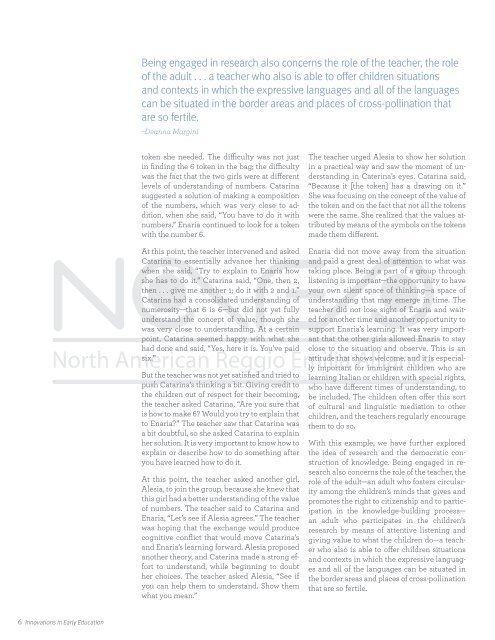Innovations
INNOV23.3web
INNOV23.3web
Create successful ePaper yourself
Turn your PDF publications into a flip-book with our unique Google optimized e-Paper software.
Being engaged in research also concerns the role of the teacher, the role<br />
of the adult . . . a teacher who also is able to offer children situations<br />
and contexts in which the expressive languages and all of the languages<br />
can be situated in the border areas and places of cross-pollination that<br />
are so fertile.<br />
–Deanna Margini<br />
token she needed. The difficulty was not just<br />
in finding the 6 token in the bag; the difficulty<br />
was the fact that the two girls were at different<br />
levels of understanding of numbers. Catarina<br />
suggested a solution of making a composition<br />
of the numbers, which was very close to addition,<br />
when she said, “You have to do it with<br />
numbers.” Enaria continued to look for a token<br />
with the number 6.<br />
At this point, the teacher intervened and asked<br />
Catarina to essentially advance her thinking<br />
when she said, “Try to explain to Enaria how<br />
she has to do it.” Catarina said, “One, then 2,<br />
then . . . give me another 1; do it with 2 and 1.”<br />
Catarina had a consolidated understanding of<br />
numerosity—that 6 is 6—but did not yet fully<br />
understand the concept of value, though she<br />
was very close to understanding. At a certain<br />
point, Catarina seemed happy with what she<br />
had done and said, “Yes, here it is. You’ve paid<br />
six.”<br />
But the teacher was not yet satisfied and tried to<br />
push Catarina’s thinking a bit. Giving credit to<br />
the children out of respect for their becoming,<br />
the teacher asked Catarina, “Are you sure that<br />
is how to make 6? Would you try to explain that<br />
to Enaria?” The teacher saw that Catarina was<br />
a bit doubtful, so she asked Catarina to explain<br />
her solution. It is very important to know how to<br />
explain or describe how to do something after<br />
you have learned how to do it.<br />
At this point, the teacher asked another girl,<br />
Alesia, to join the group, because she knew that<br />
this girl had a better understanding of the value<br />
of numbers. The teacher said to Catarina and<br />
Enaria, “Let’s see if Alesia agrees.” The teacher<br />
was hoping that the exchange would produce<br />
cognitive conflict that would move Catarina’s<br />
and Enaria’s learning forward. Alesia proposed<br />
another theory, and Caterina made a strong effort<br />
to understand, while beginning to doubt<br />
her choices. The teacher asked Alesia, “See if<br />
you can help them to understand. Show them<br />
what you mean.”<br />
The teacher urged Alesia to show her solution<br />
in a practical way and saw the moment of understanding<br />
in Caterina’s eyes. Catarina said,<br />
“Because it [the token] has a drawing on it.”<br />
She was focusing on the concept of the value of<br />
the token and on the fact that not all the tokens<br />
were the same. She realized that the values attributed<br />
by means of the symbols on the tokens<br />
made them different.<br />
Enaria did not move away from the situation<br />
and paid a great deal of attention to what was<br />
taking place. Being a part of a group through<br />
listening is important—the opportunity to have<br />
your own silent space of thinking—a space of<br />
understanding that may emerge in time. The<br />
teacher did not lose sight of Enaria and waited<br />
for another time and another opportunity to<br />
support Enaria’s learning. It was very important<br />
that the other girls allowed Enaria to stay<br />
close to the situation and observe. This is an<br />
attitude that shows welcome, and it is especially<br />
important for immigrant children who are<br />
learning Italian or children with special rights,<br />
who have different times of understanding, to<br />
be included. The children often offer this sort<br />
of cultural and linguistic mediation to other<br />
children, and the teachers regularly encourage<br />
them to do so.<br />
With this example, we have further explored<br />
the idea of research and the democratic construction<br />
of knowledge. Being engaged in research<br />
also concerns the role of the teacher, the<br />
role of the adult—an adult who fosters circularity<br />
among the children’s minds that gives and<br />
promotes the right to citizenship and to participation<br />
in the knowledge-building process—<br />
an adult who participates in the children’s<br />
research by means of attentive listening and<br />
giving value to what the children do—a teacher<br />
who also is able to offer children situations<br />
and contexts in which the expressive languages<br />
and all of the languages can be situated in<br />
the border areas and places of cross-pollination<br />
that are so fertile.<br />
6 <strong>Innovations</strong> in Early Education


